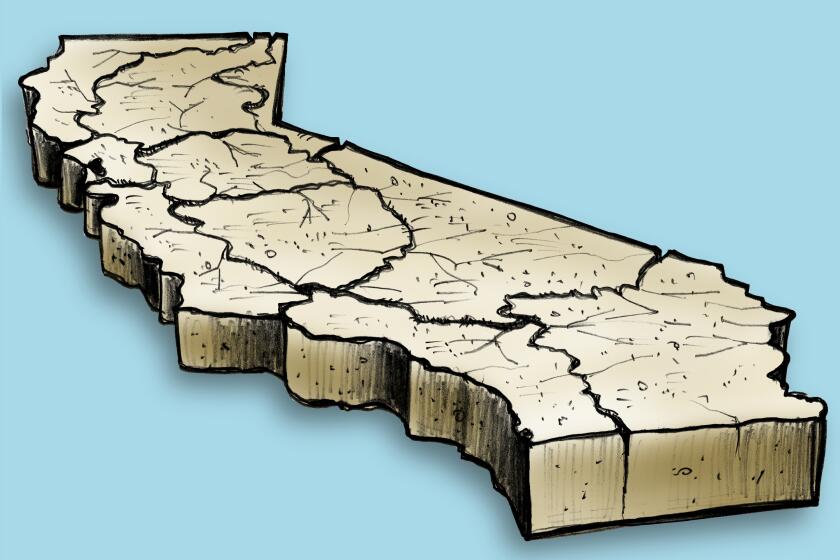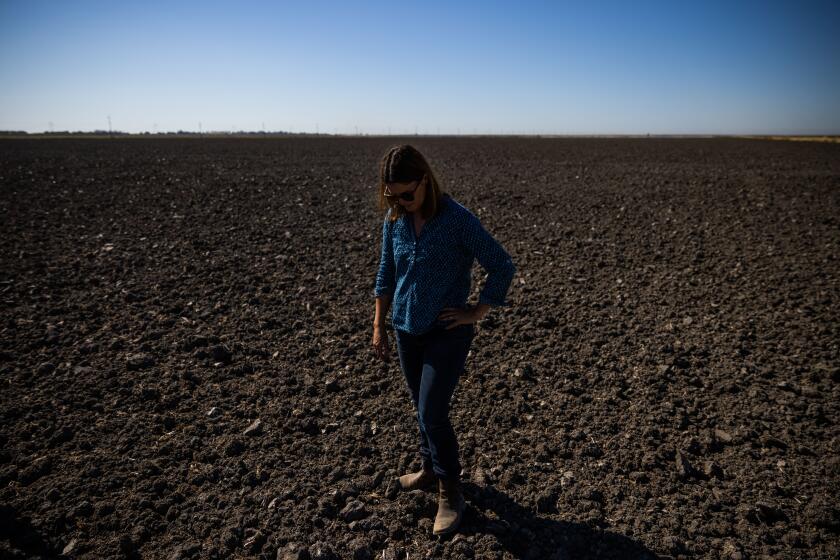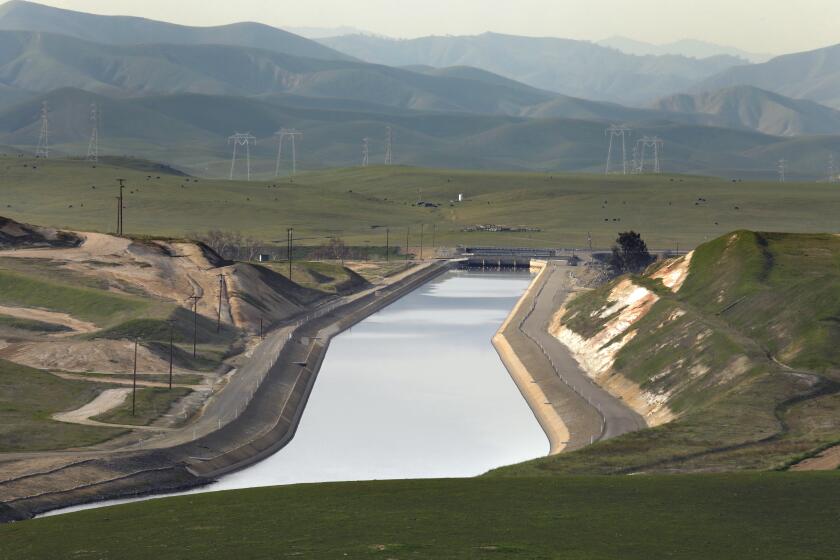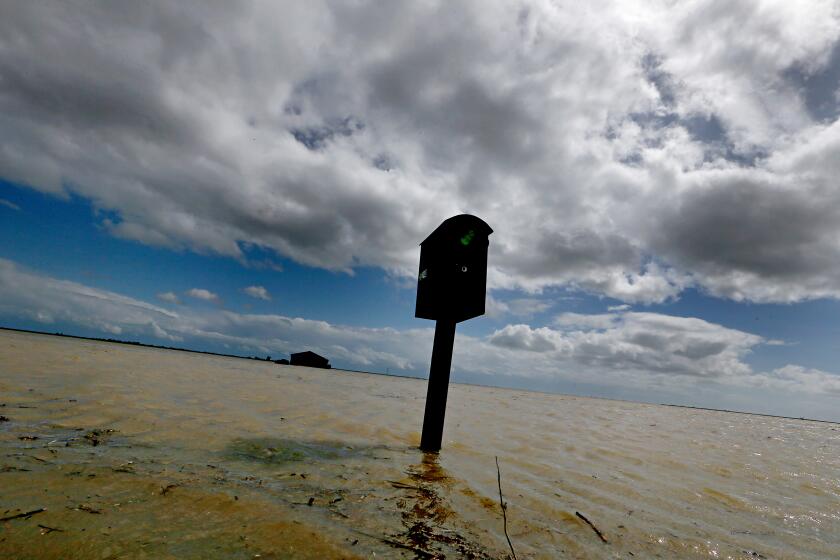Newsom rolls back California drought restrictions after remarkably wet winter
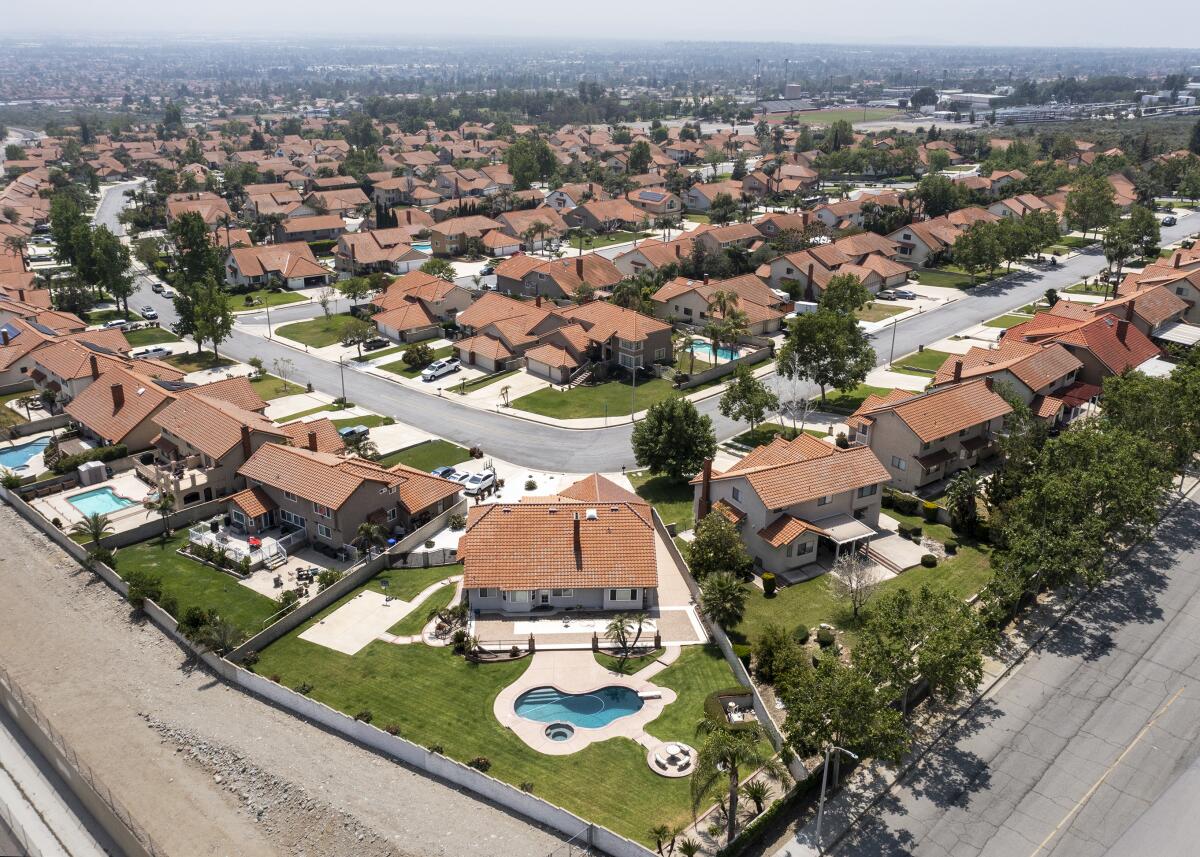
- Share via
DUNNIGAN, Calif. — On the heels of one of California’s wettest winters on record, Gov. Gavin Newsom on Friday announced that he will roll back some of the state’s most severe drought restrictions and dramatically increase water supplies for agencies serving 27 million people.
Among the rescinded items is Newsom’s call for a voluntary 15% reduction in water use, issued amid drying conditions in July 2021. He declared a statewide drought emergency that October.
The governor also rescinded a March 2022 order requiring urban water suppliers to activate Level 2 of their water shortage contingency plans, which indicates a shortage of 20% and prompts increased conservation actions.
Newsom made the announcement at a ranch in the green Dunnigan Hills in Yolo County, north of Sacramento, where rice and almond farmers were celebrating the wet winter and have been able to recharge some groundwater supplies this season for crops.
But Newsom stopped short of declaring that the drought is over, saying some parts of his drought emergency order remain important as California adapts to volatile weather patterns and the looming possibility of another long dry spell.
“It’s incumbent upon us to continue to maintain our vigilance and maintain some provisions of the executive order to allow for fast tracking of groundwater replenishment projects, stormwater capture and recycling programs here in the state of California,” he said.
Provisions around wasteful use will remain in place, including prohibitions on watering lawns within 48 hours of rainfall and using hoses without shut-off nozzles. A ban on watering nonfunctional turf at commercial and industrial properties is also unchanged.
The snow-capped Sierra Nevada and the Santa Monica Mountains north of Malibu are among the areas of California no longer considered to be in drought.
The remarkable turnaround comes after California’s driest three years on record left reservoirs drained and water supplies drastically reduced.
A series of drenching storms at the start of this year helped ease some of the most extreme drought conditions in the state, refilling rivers and reservoirs and delivering near-record snowpack in the Sierra Nevada.
State water agencies — which were girding to receive only 35% of requested supplies from the State Water Project this year — will now get 75%, officials from the Department of Water Resources said. The State Water Project is a vast network of reservoirs, canals and dams that acts as a major component of California’s water system.
“We’ve been able to do this because of the series of winter storms that have really provided robust flows throughout the system,” said John Yarbrough, assistant deputy director at DWR.
At a 35% allocation, the agency would have delivered about 1.4 million acre-feet of water to its 29 member agencies, Yarbrough said. The increase will “more than double that amount” to about 3.1 million acre-feet. An acre-foot is approximately 326,000 gallons.
The latest maps and charts on the California drought, including water usage, conservation and reservoir levels.
The allocation could increase even more in April, Yarbrough said. However, he and other officials stressed that the governor’s emergency proclamation was being modified — not removed.
“We’re modifying it as opposed to eliminating it because first, there are portions of the state that continue to experience acute water shortages,” said California Natural Resources Secretary Wade Crowfoot. That includes the Klamath Basin in far Northern California and portions of Southern California that depend on the Colorado River, he said.
“We’re also maintaining yet modifying the proclamation because there are continued emergency impacts and drought conditions across the state, including ... communities and households that lack drinking water coming out of their taps,” Crowfoot said.
Assemblyman Vince Fong (R-Bakersfield) said the Newsom administration should go further to make more water available to communities and fund water infrastructure.
“More restrictions must be removed to maximize water supplies to Californians,” he said in a statement.
“It is time for the Governor to prioritize funding for water storage, conveyance and other necessary water infrastructure, while also expediting much needed flood protection to safeguard our communities in the future.”
A third year of severe drought forced California farmers to leave an estimated 752,000 acres of farmland idle this year, according to a new report.
Still, the change was welcome news after a grueling, bone-dry three years wrought devastation on the lives and businesses of millions of Californians.
In 2022, significant cuts in water deliveries saw irrigated farmland shrink by 752,000 acres — cutting crop revenues by $1.7 billion and costing an estimated 12,000 agricultural jobs.
The number of dry wells soared, particularly in the Central Valley, as farmers continued to suck supplies from the ground to make up for reduced allocations, often leaving the state’s most vulnerable residents with little water and even less recourse.
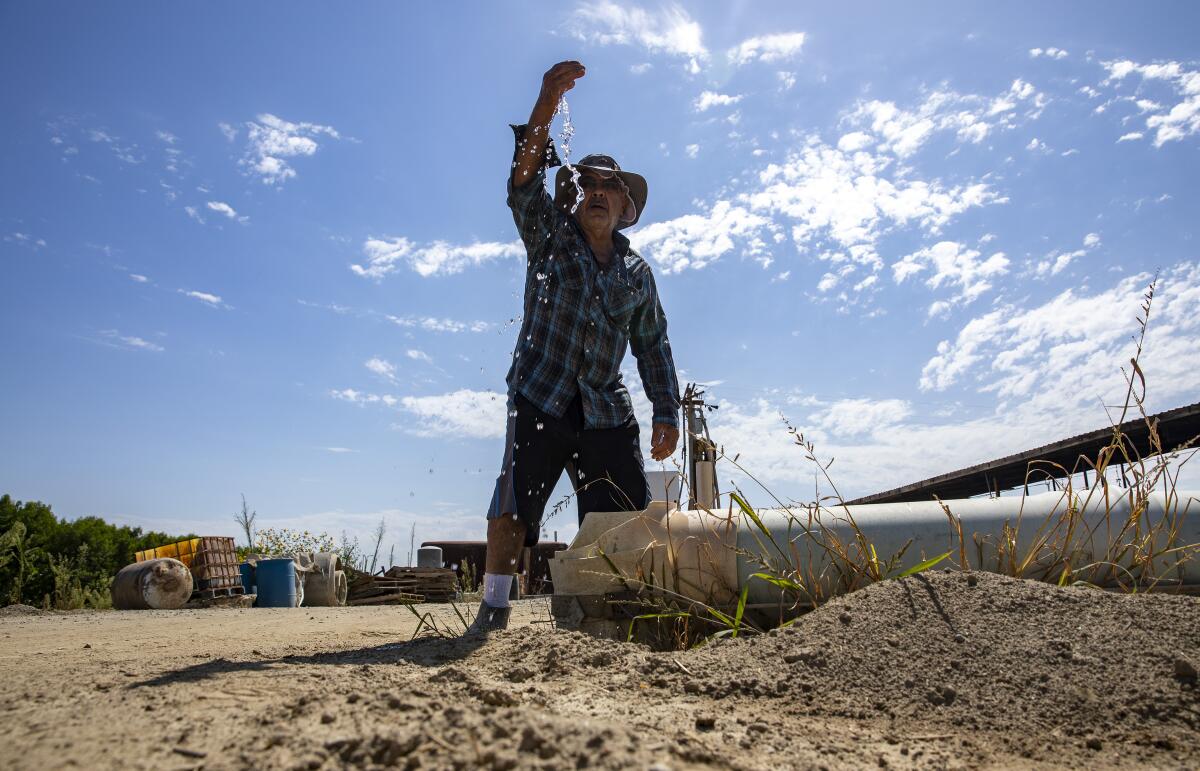
Urban areas also saw unprecedented water restrictions that led to one- and two-day-a-week outdoor watering limits for 7 million people in Southern California, among other rules.
The region’s massive water wholesaler, the Metropolitan Water District of Southern California, lifted some of its restrictions last week, but local water suppliers may still have regulations in place.
Newsom administration officials said provisions centered on groundwater supplies will also remain in place, including those that enable the state to assist communities with dry wells and respond to emergencies as needed.
The provisions reflect that “we continue to have a groundwater drought, a groundwater deficit,” said Joaquin Esquivel, chair of the State Water Resources Control Board.
Despite the surface water surplus, deficits in groundwater won’t be remedied by a single wet year, he said.
Crowfoot said removing the 15% voluntary reduction is part of a larger goal to move away from numeric targets and focus on a “more durable approach” to making conservation a way of life.
“It’s not about going back to normal anymore — it’s really adjusting to a new normal, and that is intensifying extremes,” Crowfoot said. He said he would not declare the drought over.
“If we declared the drought over and removed any emergency provisions, we would be unable to quickly and effectively provide support where those conditions still exist,” he said, such as providing bottled water supplies to communities whose wells have run dry.
California has approved a plan to use more than 600,000 acre-feet of floodwaters to replenish groundwater and supply wildlife refuges in the Central Valley.
Such “climate whiplash” behavior — or swings between extreme wetness and dryness — was exemplified by the recent storms, including deadly blizzards in the San Bernardino Mountains and devastating flooding in Monterey County and the Central Valley.
The flooding — driven in many places by levee breaches — shined a spotlight on the state’s aging infrastructure and drew criticism from communities left in harm’s way.
Swelling rivers in the Sacramento-San Joaquin River Delta area, Los Angeles and other parts of the state this winter also drew criticism of California’s ability to capture stormwater at state and local levels and to adequately manage flows for humans and the environment.
Water managers said they are working to boost the state’s ability to capture and store water and to modernize infrastructure under the governor’s Strategy for a Hotter, Drier California, unveiled last August. Those efforts include recent moves to divert more than 600,000 acre-feet of water from the swollen San Joaquin River to help replenish groundwater basins in the Central Valley.
“I take a backseat to no governor in the United States of America in terms of my environmental stewardship and passion,” Newsom said. “But we have a responsibility to one another to also recognize the nature of change. Things are not static. They’re not the way they were 20, 30, 40 years ago, and we have to be more nimble and we have to be more flexible.”
As historic storms fill once-dry Tulare Lake and submerge prime California farmland, tensions are building over how to handle the swiftly rising floodwaters.
State officials also acknowledged that Southern California’s other major source — the Colorado River — remains in dire condition.
The river is a water lifeline that supplies about 40 million people, but drought and overuse have left its reservoirs dangerously low, with water managers warning that Lake Mead could soon drop below its lowest intake valve and effectively cut off supplies for the American West.
Federal officials have ordered California and six other states to drastically reduce their use of that river, but so far no agreement has been reached.
California, meanwhile, has received a bounty unlike any in recent memory.
Nearly 65% of the state is no longer in drought, the U.S. Drought Monitor shows. Just three months ago, almost 100% of the state was mired in some form of dryness.
By Friday, statewide snowpack was 228% of normal for the date. Snowpack in the southern Sierra was 286% of normal — an all-time record.
California’s two largest reservoirs, Lake Shasta and Lake Oroville, were at 78% and 82% of capacity, respectively.
“It’s a milestone,” Newsom said. “We’re not fully out of the woods, but none of us could have imagined a few months ago that we’d be where we are today.”
Yet another storm system could drop more rain and snow on the state early next week, forecasters said.
Times staff writer Ian James contributed to this report.
More to Read
Sign up for Essential California
The most important California stories and recommendations in your inbox every morning.
You may occasionally receive promotional content from the Los Angeles Times.

